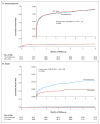Randomized trial of primary PCI with or without routine manual thrombectomy
- PMID: 25853743
- PMCID: PMC4995102
- DOI: 10.1056/NEJMoa1415098
Randomized trial of primary PCI with or without routine manual thrombectomy
Abstract
Background: During primary percutaneous coronary intervention (PCI), manual thrombectomy may reduce distal embolization and thus improve microvascular perfusion. Small trials have suggested that thrombectomy improves surrogate and clinical outcomes, but a larger trial has reported conflicting results.
Methods: We randomly assigned 10,732 patients with ST-segment elevation myocardial infarction (STEMI) undergoing primary PCI to a strategy of routine upfront manual thrombectomy versus PCI alone. The primary outcome was a composite of death from cardiovascular causes, recurrent myocardial infarction, cardiogenic shock, or New York Heart Association (NYHA) class IV heart failure within 180 days. The key safety outcome was stroke within 30 days.
Results: The primary outcome occurred in 347 of 5033 patients (6.9%) in the thrombectomy group versus 351 of 5030 patients (7.0%) in the PCI-alone group (hazard ratio in the thrombectomy group, 0.99; 95% confidence interval [CI], 0.85 to 1.15; P=0.86). The rates of cardiovascular death (3.1% with thrombectomy vs. 3.5% with PCI alone; hazard ratio, 0.90; 95% CI, 0.73 to 1.12; P=0.34) and the primary outcome plus stent thrombosis or target-vessel revascularization (9.9% vs. 9.8%; hazard ratio, 1.00; 95% CI, 0.89 to 1.14; P=0.95) were also similar. Stroke within 30 days occurred in 33 patients (0.7%) in the thrombectomy group versus 16 patients (0.3%) in the PCI-alone group (hazard ratio, 2.06; 95% CI, 1.13 to 3.75; P=0.02).
Conclusions: In patients with STEMI who were undergoing primary PCI, routine manual thrombectomy, as compared with PCI alone, did not reduce the risk of cardiovascular death, recurrent myocardial infarction, cardiogenic shock, or NYHA class IV heart failure within 180 days but was associated with an increased rate of stroke within 30 days. (Funded by Medtronic and the Canadian Institutes of Health Research; TOTAL ClinicalTrials.gov number, NCT01149044.).
Figures


Comment in
-
Coronary microvascular obstruction--a puzzle with many pieces.N Engl J Med. 2015 Apr 9;372(15):1464-5. doi: 10.1056/NEJMe1501882. Epub 2015 Mar 16. N Engl J Med. 2015. PMID: 25853751 No abstract available.
-
ACP Journal Club. In STEMI, manual thrombectomy before PCI did not reduce CV-related outcomes but increased stroke.Ann Intern Med. 2015 Jun 16;162(12):JC2. doi: 10.7326/ACPJC-2015-162-12-002. Ann Intern Med. 2015. PMID: 26075779 No abstract available.
-
[Myocardial infarction: manual thrombectomy before PCI does not improve the result].Dtsch Med Wochenschr. 2015 May;140(10):711. Dtsch Med Wochenschr. 2015. PMID: 26171475 German. No abstract available.
-
Primary PCI with or without Thrombectomy.N Engl J Med. 2015 Aug 13;373(7):682-3. doi: 10.1056/NEJMc1507110. N Engl J Med. 2015. PMID: 26267630 No abstract available.
-
Primary PCI with or without Thrombectomy.N Engl J Med. 2015 Aug 13;373(7):680. doi: 10.1056/NEJMc1507110. N Engl J Med. 2015. PMID: 26267631 No abstract available.
-
Primary PCI with or without Thrombectomy.N Engl J Med. 2015 Aug 13;373(7):680-1. doi: 10.1056/NEJMc1507110. N Engl J Med. 2015. PMID: 26267632 No abstract available.
-
Primary PCI with or without Thrombectomy.N Engl J Med. 2015 Aug 13;373(7):681. doi: 10.1056/NEJMc1507110. N Engl J Med. 2015. PMID: 26267633 No abstract available.
-
Primary PCI with or without Thrombectomy.N Engl J Med. 2015 Aug 13;373(7):681-2. doi: 10.1056/NEJMc1507110. N Engl J Med. 2015. PMID: 26267634 No abstract available.
-
Primary PCI with or without Thrombectomy.N Engl J Med. 2015 Aug 13;373(7):682. doi: 10.1056/NEJMc1507110. N Engl J Med. 2015. PMID: 26267635 No abstract available.
References
-
- Keeley EC, Boura JA, Grines CL. Primary angioplasty versus intravenous thrombolytic therapy for acute myocardial infarction: a quantitative review of 23 randomised trials. Lancet. 2003;361:13–20. - PubMed
-
- Buller CE, Fu Y, Mahaffey KW, et al. ST-segment recovery and outcome after primary percutaneous coronary intervention for ST-elevation myocardial infarction: insights from the Assessment of Pexelizumab in Acute Myocardial Infarction (APEX-AMI) trial. Circulation. 2008;118:1335–46. - PubMed
-
- Stone GW, Peterson MA, Lansky AJ, Dangas G, Mehran R, Leon MB. Impact of normalized myocardial perfusion after successful angioplasty in acute myocardial infarction. J Am Coll Cardiol. 2002;39:591–7. - PubMed
-
- De Luca G, Dudek D, Sardella G, Marino P, Chevalier B, Zijlstra F. Adjunctive manual thrombectomy improves myocardial perfusion and mortality in patients undergoing primary percutaneous coronary intervention for ST-elevation myocardial infarction: a meta-analysis of randomized trials. Eur Heart J. 2008;29:3002–10. - PubMed
-
- Svilaas T, Vlaar PJ, van der Horst IC, et al. Thrombus aspiration during primary percutaneous coronary intervention. N Engl J Med. 2008;358:557–67. - PubMed
Publication types
MeSH terms
Associated data
Grants and funding
LinkOut - more resources
Full Text Sources
Other Literature Sources
Medical
Miscellaneous
